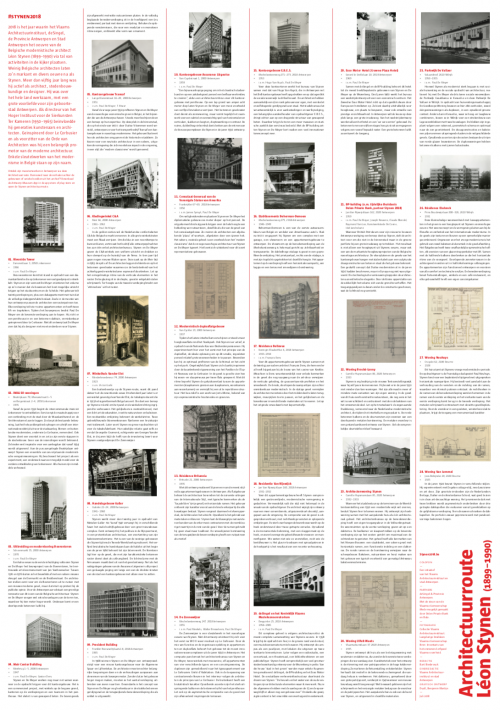PUBLICATIONS
(EN) Léon Stynen. A Life of Architecture (1899-1990)

Author: Tom Avermaete, Inge Bertels, Sofie De Caigny, Bart Decroos, Fredie Floré, Janina Gosseye, Christoph Grafe, Dirk Laureys, Bruno Notteboom, Bart Tritsmans, Stephanie Van de Voorde, Karina Van Herck, Ellen Van Impe, Luc Verpoest, Caroline Voet
Publisher: Vlaams Architectuurinstituut, Antwerp (2018)
Dimensions 200 x 275 mm
Pages: 336
Language: English
ISBN: 9789492567116
At the vernissage of the exhibition Léon Stynen, architect on 11 October 2018 a new publication about the architect was published, titled ‘Léon Stynen. A Life of Architecture (1899-1990)’.
The Flanders Architecture Institute gathered a group of authors who discuss thematic essays on, among other things, Stynens housing projects, his use of materials, his relation to the city, his role in architectural education, his contribution to leisure architecture and interior design. The essays are preceded by a chronological overview of his life and work and a selection of top monuments from Stynens’s oeuvre.
The texts are richly illustrated with sketches, photographs and architectural drawings from Stynens architectural archive. In a separate section, new photographs by architectural photographer Filip Dujardin present an up-to-date view of Stynen’s oeuvre. The design is in the hands of Sven Beirnaert.
Order now online at Flanders Architecture Institute website
For the true Stynen-aficionados, together with the City of Antwerp, the Flanders Architecture Institute developed a Stynen architecture tour. You can acces the tour by downloading the Antwerp Museum App in your app store (available form 26 August 2018) or download the route here.
PREFACE
Léon Stynen was without doubt one of Belgium’s most important architects of the twentieth century. Few Belgian architects have left a more striking and varied body of work. He owes his fame not only to the scale and quality of his work, but also to the role he played within architectural education and the professional organization of architects’ associations. His work can be read as a reflection of social, economic and intellectual evolutions in architecture.
Educated in a traditional academic context, he started to adopt a modern idiom and attitude in the interwar period, challenged by his international peers. In the booming first decades of the welfare state, Stynen managed to obtain important commissions for public and private buildings.
His architecture mediated between the desires of his clients, a growing professionalization of the building culture, and his knowledge of the work of international architects he admired.
Although the impact of his work and of his institutional engagement is of great importance in Belgium, Stynen is not known abroad. In this, Stynen’s case is no different from the wider post-war Belgian architectural scene, which failed to produce any internationally renowned masters after Victor Horta and Henry van de Velde. This situation is similar to other peripheral architectural scenes. Comparable architects working in different regions across Europe developed equally iconic oeuvres. Many of them had a profound impact on the architectural scene in their home countries, but remain rather unknown outside the national circuit.
With this publication on Léon Stynen, the Flanders Architecture Institute wants to shed new light on his oeuvre by studying the rich archive of the office of Stynen and De Meyer. Together with the international symposium held in December 2017 titled Architecture and Professionalism: New approaches to the work of Léon Stynen and his international contemporaries, we want to contribute to a growing international dialogue about these architects that remain rather unknown in the international canon.
At the same time, and equally importantly, we aspire to raise local awareness for his work. That is why the Flanders Architecture Institute put Stynen at the centre of its activities in 2018. Together with a variety of partners, we are organizing an exhibition, a series of lectures, a contribution to the National Heritage Day, and an education program. This diverse cultural program also seeks to stimulate a debate on the contemporary meaning of his oeuvre and on how contemporary designers and inhabitants can approach it.
Our focus is on Stynen because it has been 30 years since he donated his archive to the province of Antwerp. He was one of the first architects to enrich the newly established Architectural Archives of the Province of Antwerp. After 1988 the collection grew rapidly and now holds more than 160 private archives of architects. In 2018 the collection was transferred from the province to the Flanders Architecture Institute. As a result, one could say that Stynen’s archive formed the start of the collection of the Flanders Architecture Institute. As someone who worked hard not only for his own office and buildings, but also for the profession of architecture, its education and the social position of architecture, this is something that Stynen would undoubtedly have loved. He would have deeply appreciated the idea of an architectural institute that addresses current spatial challenges, but that also curates its past and memory. The fact that the Flanders Architecture Institute is housed in deSingel Arts Centre, one of Stynen’s most important buildings with is currently undergoing important alterations, underlined for us even more the contemporary relevance of highlighting the work of Léon Stynen.
preface by Dr Sofie De Caigny, director of the Flanders Architecture Institute
CONTENTS
Preface
Introduction
A Life of Architecture, 1899-1990
Selected Works
Key Monuments
Photography by Filip Dujardin
Essays
– Classic Modernism. Léon Stynen’s Houses
– Architecture and Civilization.
– Stynen and the City
– Grand Designs. Léon Stynen’s Architecture for Leisure
– Interiors for Working, Traveling and Shopping. Scenographies for an Internationalizing Society
– Material Wealth and Standard Practices. Léon Stynen’s Oeuvre Seen from the Perspective of Construction History
– Architecture and Commitment. Léon Stynen and Architectural Education
– The Ideas of a Small Avant-Garde at Large. Situating Stynen’s Professional Practice in the Post-War Period
– Epilogue. Engaging Léon Stynen. Contemporary Interventions in the Royal Flanders Music Conservatoire
Bibliography Essays
Authors
Index
Colophon




